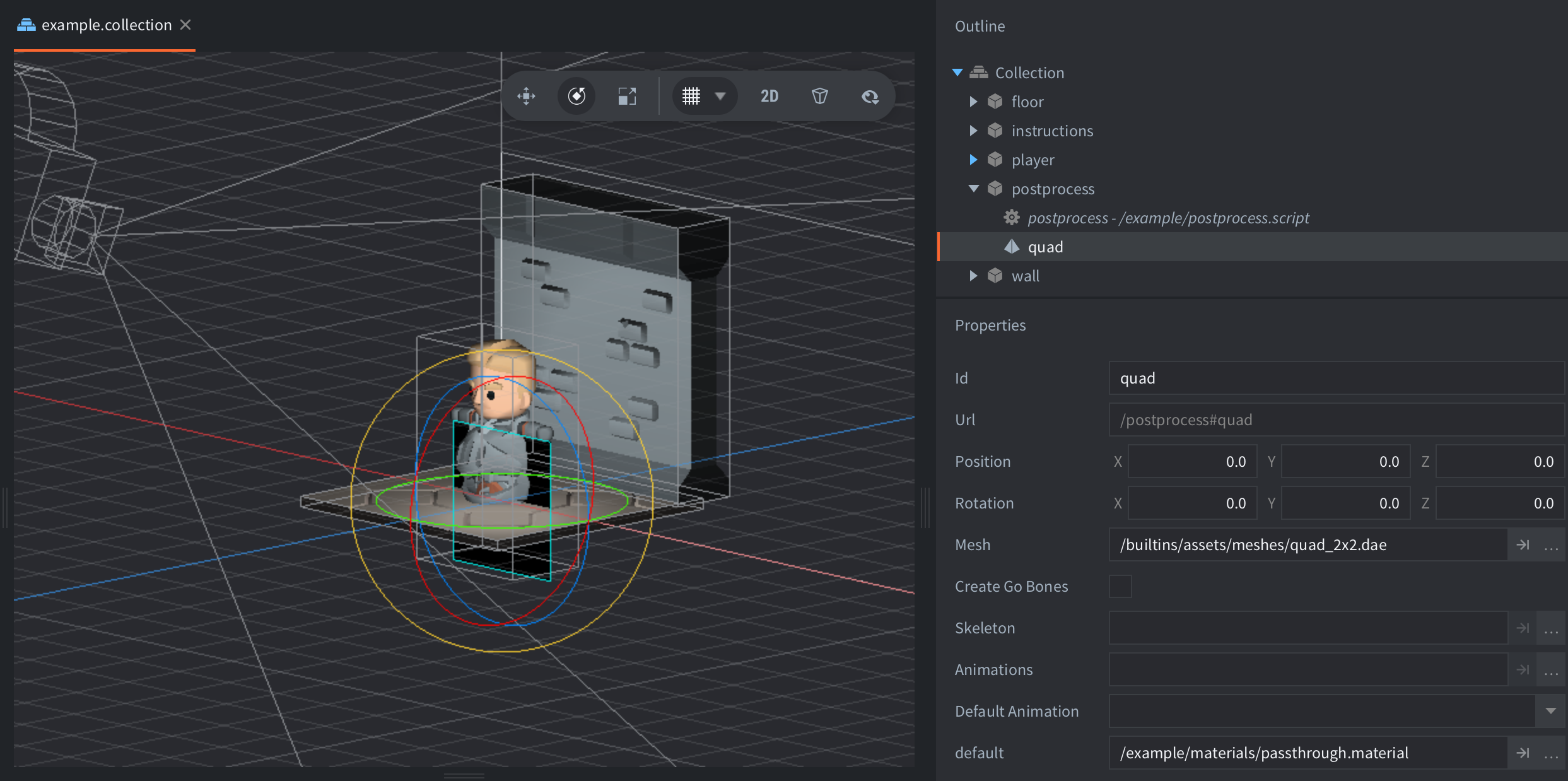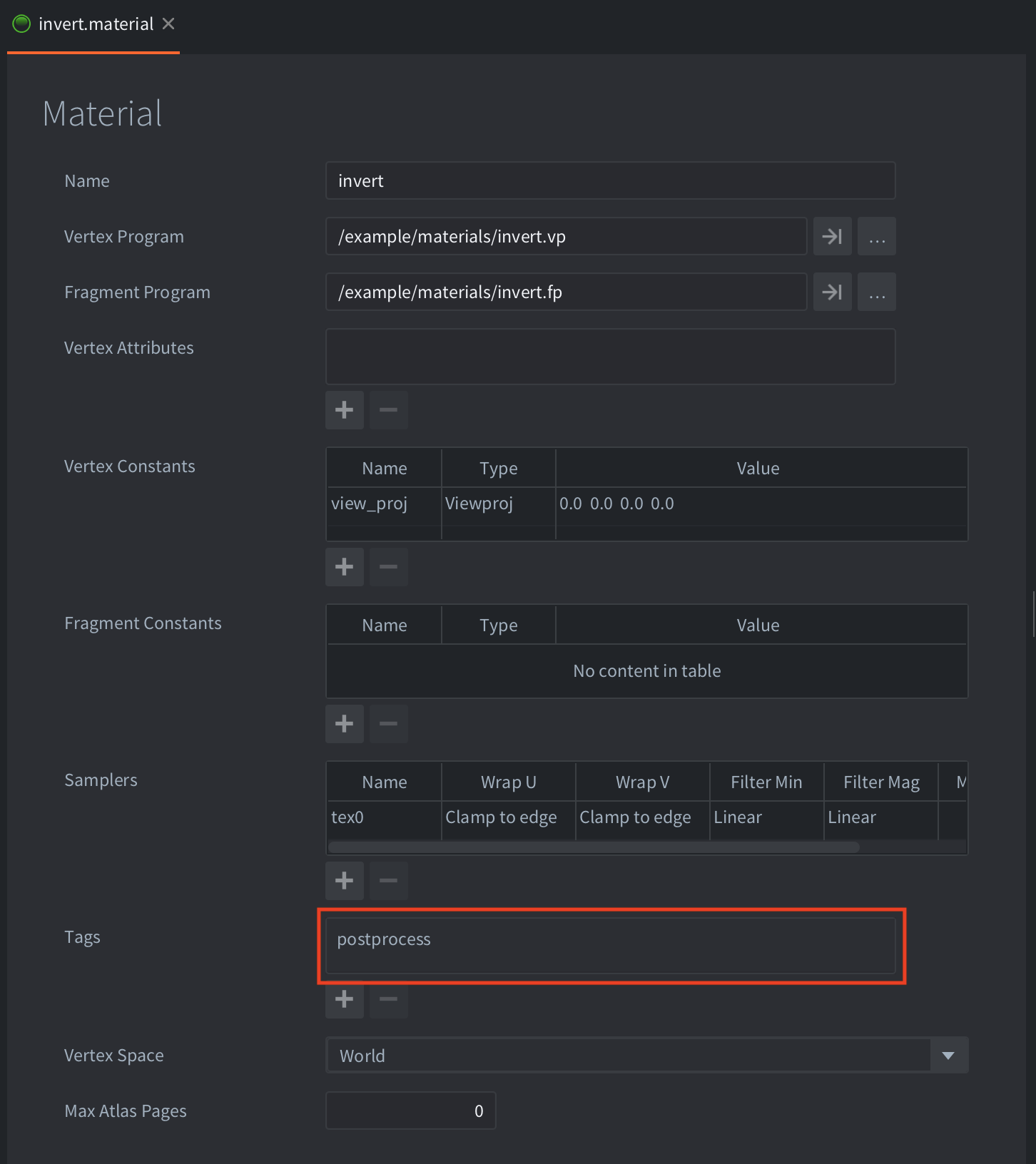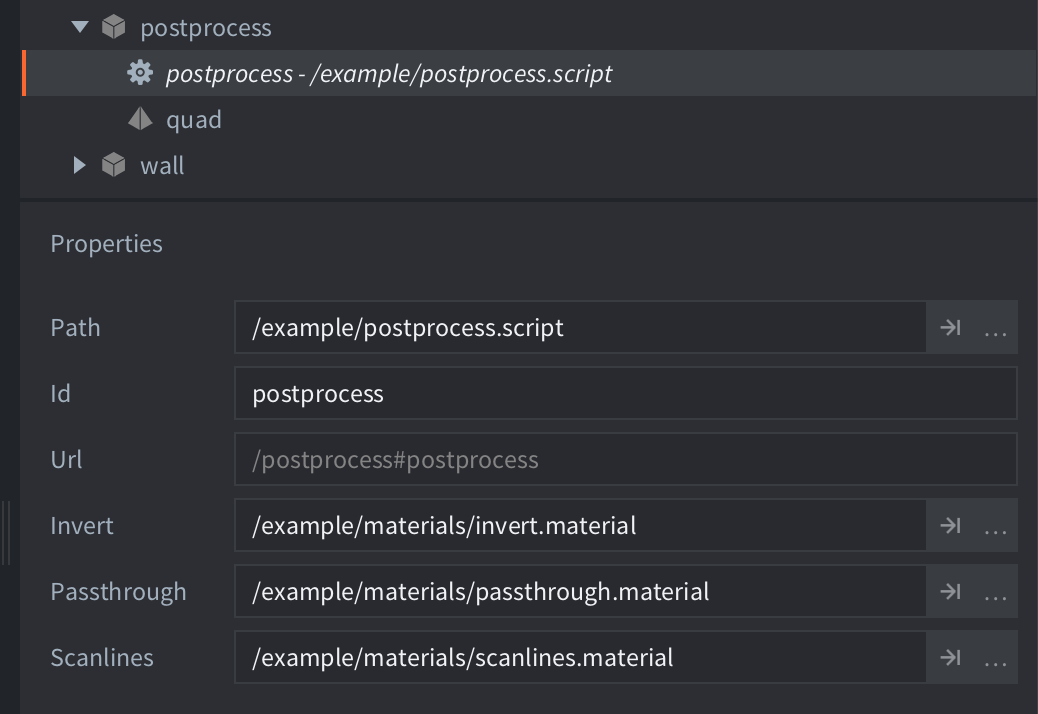Post-processing
Setup
The basic principle of a full screen post processing effect is to first draw the entire game to a render target, then draw this render target to a full screen quad using a post processing shader to apply some kind of effect. This example shows a color invert effect and a CRT scanline effect.
The setup in this example consists of a custom render script and a game object containing a model component with a fullscreen quad (ie rectangle).

The model uses a material with a render predicate/tag named postprocess. The material uses a basic shader program in invert.fp to invert the color of anything drawn with the material.

The render script is a copy of the default render script with added code to create a fullscreen render target. The render target has a color and depth buffer, and it will be resized if the screen resolution changes:
local function create_postprocess_rt(self, width, height)
local color_params = {
format = graphics.TEXTURE_FORMAT_RGBA,
width = width,
height = height,
min_filter = render.FILTER_LINEAR,
mag_filter = render.FILTER_LINEAR,
u_wrap = render.WRAP_CLAMP_TO_EDGE,
v_wrap = render.WRAP_CLAMP_TO_EDGE
}
local depth_params = {
format = graphics.TEXTURE_FORMAT_DEPTH,
width = width,
height = height,
}
self.postprocess_rt = render.render_target("postprocess_rt", { [render.BUFFER_COLOR_BIT] = color_params, [render.BUFFER_DEPTH_BIT] = depth_params } )
self.postprocess_rt_width = width
self.postprocess_rt_height = height
end
local function update_postprocess_rt(self)
local w = render.get_window_width()
local h = render.get_window_height()
-- keep render target if size is the same
if self.postprocess_rt_width == w and self.postprocess_rt_height == h then
return
end
render.delete_render_target(self.postprocess_rt)
create_postprocess_rt(self, w, h)
end
function init(self)
-- create the postprocess predicate and all of the default predicates
self.predicates = create_predicates("postprocess", "tile", "gui", "particle", "model", "debug_text")
create_postprocess_rt(self, render.get_window_width(), render.get_window_height())
end
function update(self)
update_postprocess_rt(self)
end
The render script is additionally modified so that all content is drawn to the render target instead of directly to the screen. In a separate step at the end, the render target is used as a texture and drawn to the fullscreen quad with the postprocess predicate using the post processing shader assigned to the model quad:
function update(self)
update_postprocess_rt(self)
-- enable postprecssing render target
-- subsequent draw operations will be done to the render target
--
render.set_render_target(self.postprocess_rt)
-- note: some render code removed from this snippet to make it readable
render.draw(predicates.model, draw_options_world)
render.draw(predicates.tile, draw_options_world)
render.draw(predicates.particle, draw_options_world)
render.draw(predicates.gui, camera_gui.options)
render.draw(predicates.debug_text, camera_gui.options)
-- revert to the default render target
--
render.set_render_target(render.RENDER_TARGET_DEFAULT)
-- render post processing render target to quad with predicate 'postprocess'
--
render.set_view(vmath.matrix4())
render.set_projection(vmath.matrix4())
render.enable_texture(0, self.postprocess_rt, render.BUFFER_COLOR_BIT)
render.draw(predicates.postprocess)
render.disable_texture(0)
end
Additionally the example shows in postprocess.script how to change material using material resource properties at runtime.

Scripts
postprocess.script
go.property("invert", resource.material("/example/materials/invert.material"))
go.property("passthrough", resource.material("/example/materials/passthrough.material"))
go.property("scanlines", resource.material("/example/materials/scanlines.material"))
function init(self)
msg.post(".", "acquire_input_focus")
go.set("#quad", "material", self.invert)
end
function on_input(self, action_id, action)
if action_id == hash("key_1") then
go.set("#quad", "material", self.invert)
elseif action_id == hash("key_2") then
go.set("#quad", "material", self.scanlines)
local w, h = window.get_size()
go.set("#quad", "resolution", vmath.vector4(w, h, 0, 0))
elseif action_id == hash("key_3") then
go.set("#quad", "material", self.passthrough)
end
endinvert.fp
#version 140
in mediump vec2 var_texcoord0;
out vec4 out_fragColor;
uniform mediump sampler2D tex0;
void main()
{
vec4 color = texture(tex0, var_texcoord0.xy);
color.r = 1.0 - color.r;
color.g = 1.0 - color.g;
color.b = 1.0 - color.b;
out_fragColor = vec4(color.rgb,1.0);
}invert.vp
#version 140
in highp vec4 position;
in mediump vec2 texcoord0;
out mediump vec2 var_texcoord0;
uniform vs_uniforms
{
highp mat4 view_proj;
};
void main()
{
gl_Position = view_proj * vec4(position.xyz, 1.0);
var_texcoord0 = texcoord0;
}